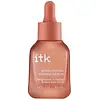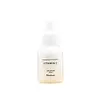What's inside
What's inside
 Key Ingredients
Key Ingredients

 Benefits
Benefits

 Concerns
Concerns

No concerns
 Ingredients Side-by-side
Ingredients Side-by-side

Water
Skin ConditioningGlycerin
HumectantCoco-Caprylate
EmollientCaprylic/Capric Triglyceride
MaskingPropanediol
SolventSilica
AbrasiveAscorbyl Tetraisopalmitate
AntioxidantNiacinamide
SmoothingAscorbyl Glucoside
AntioxidantBiosaccharide Gum-1
HumectantPhenoxyethanol
PreservativePolyacrylate Crosspolymer-6
Emulsion StabilisingButylene Glycol
HumectantAminomethyl Propanol
BufferingC14-22 Alcohols
Emulsion StabilisingC12-20 Alkyl Glucoside
EmulsifyingPanthenol
Skin ConditioningEthylhexylglycerin
Skin ConditioningDisodium EDTA
Plukenetia Volubilis Seed Oil
EmollientAllantoin
Skin ConditioningDisodium Phosphate
BufferingSodium Lactate
BufferingCarbomer
Emulsion StabilisingSodium Hyaluronate
HumectantCalcium Dihydrogen Phosphate
BufferingPolysorbate 20
EmulsifyingTocopherol
AntioxidantPalmitoyl Tripeptide-1
Skin ConditioningPalmitoyl Tetrapeptide-7
Skin ConditioningWater, Glycerin, Coco-Caprylate, Caprylic/Capric Triglyceride, Propanediol, Silica, Ascorbyl Tetraisopalmitate, Niacinamide, Ascorbyl Glucoside, Biosaccharide Gum-1, Phenoxyethanol, Polyacrylate Crosspolymer-6, Butylene Glycol, Aminomethyl Propanol, C14-22 Alcohols, C12-20 Alkyl Glucoside, Panthenol, Ethylhexylglycerin, Disodium EDTA, Plukenetia Volubilis Seed Oil, Allantoin, Disodium Phosphate, Sodium Lactate, Carbomer, Sodium Hyaluronate, Calcium Dihydrogen Phosphate, Polysorbate 20, Tocopherol, Palmitoyl Tripeptide-1, Palmitoyl Tetrapeptide-7
Water
Skin ConditioningPropanediol
SolventAscorbic Acid 20%
AntioxidantBetaine
Humectant1,2-Hexanediol
Skin ConditioningPolyglycerin-3
HumectantTromethamine
Buffering3-O-Ethyl Ascorbic Acid
Skin ConditioningFerulic Acid
AntimicrobialEthylhexylglycerin
Skin ConditioningDisodium EDTA
Gardenia Florida Fruit Extract
Skin ConditioningDextrin
AbsorbentNiacinamide
SmoothingSaccharomyces/Rice Ferment Filtrate
Skin ConditioningButylene Glycol
HumectantSodium Hyaluronate
HumectantCynanchum Atratum Extract
Skin ConditioningHydroxypropyltrimonium Hyaluronate
Sodium Acetylated Hyaluronate
HumectantHydrolyzed Hyaluronic Acid
HumectantHyaluronic Acid
HumectantSodium Hyaluronate Crosspolymer
HumectantHydrolyzed Sodium Hyaluronate
Skin ConditioningPotassium Hyaluronate
Skin ConditioningWater, Propanediol, Ascorbic Acid 20%, Betaine, 1,2-Hexanediol, Polyglycerin-3, Tromethamine, 3-O-Ethyl Ascorbic Acid, Ferulic Acid, Ethylhexylglycerin, Disodium EDTA, Gardenia Florida Fruit Extract, Dextrin, Niacinamide, Saccharomyces/Rice Ferment Filtrate, Butylene Glycol, Sodium Hyaluronate, Cynanchum Atratum Extract, Hydroxypropyltrimonium Hyaluronate, Sodium Acetylated Hyaluronate, Hydrolyzed Hyaluronic Acid, Hyaluronic Acid, Sodium Hyaluronate Crosspolymer, Hydrolyzed Sodium Hyaluronate, Potassium Hyaluronate
Ingredients Explained
These ingredients are found in both products.
Ingredients higher up in an ingredient list are typically present in a larger amount.
Butylene Glycol (or BG) is used within cosmetic products for a few different reasons:
Overall, Butylene Glycol is a safe and well-rounded ingredient that works well with other ingredients.
Though this ingredient works well with most skin types, some people with sensitive skin may experience a reaction such as allergic rashes, closed comedones, or itchiness.
Learn more about Butylene GlycolDisodium EDTA plays a role in making products more stable by aiding other preservatives.
It is a chelating agent, meaning it neutralizes metal ions that may be found in a product.
Disodium EDTA is a salt of edetic acid and is found to be safe in cosmetic ingredients.
Learn more about Disodium EDTAEthylhexylglycerin (we can't pronounce this either) is commonly used as a preservative and skin softener. It is derived from glyceryl.
You might see Ethylhexylglycerin often paired with other preservatives such as phenoxyethanol. Ethylhexylglycerin has been found to increase the effectiveness of these other preservatives.
Niacinamide is a multitasking form of vitamin B3 that strengthens the skin barrier, reduces pores and dark spots, regulates oil, and improves signs of aging.
And the best part? It's gentle and well-tolerated by most skin types, including sensitive and reactive skin.
You might have heard of "niacin flush", or the reddening of skin that causes itchiness. Niacinamide has not been found to cause this.
In very rare cases, some individuals may not be able to tolerate niacinamide at all or experience an allergic reaction to it.
If you are experiencing flaking, irritation, and dryness with this ingredient, be sure to double check all your products as this ingredient can be found in all categories of skincare.
When incorporating niacinamide into your routine, look out for concentration amounts. Typically, 5% niacinamide provides benefits such as fading dark spots. However, if you have sensitive skin, it is better to begin with a smaller concentration.
When you apply niacinamide to your skin, your body converts it into nicotinamide adenine dinucleotide (NAD). NAD is an essential coenzyme that is already found in your cells as "fuel" and powers countless biological processes.
In your skin, NAD helps repair cell damage, produce new healthy cells, support collagen production, strengthen the skin barrier, and fight environmental stressors (like UV and pollution).
Our natural NAD levels start to decline with age, leading to slower skin repair, visible aging, and a weaker skin barrier. By providing your skin niacinamide, you're recharging your skin's NAD levels. This leads to stronger, healthier, and younger looking skin.
Another name for vitamin B3 is nicotinamide. This vitamin is water-soluble and our bodies don't store it. We obtain Vitamin B3 from either food or skincare. Meat, fish, wheat, yeast, and leafy greens contain vitamin B3.
The type of niacinamide used in skincare is synthetically created.
Learn more about NiacinamidePropanediol is an all-star ingredient. It softens, hydrates, and smooths the skin.
It’s often used to:
Propanediol is not likely to cause sensitivity and considered safe to use. It is derived from corn or petroleum with a clear color and no scent.
Learn more about PropanediolSodium Hyaluronate is hyaluronic acid's salt form. It is commonly derived from the sodium salt of hyaluronic acid.
Like hyaluronic acid, it is great at holding water and acts as a humectant. This makes it a great skin hydrating ingredient.
Sodium Hyaluronate is naturally occurring in our bodies and is mostly found in eye fluid and joints.
These are some other common types of Hyaluronic Acid:
Learn more about Sodium HyaluronateWater. It's the most common cosmetic ingredient of all. You'll usually see it at the top of ingredient lists, meaning that it makes up the largest part of the product.
So why is it so popular? Water most often acts as a solvent - this means that it helps dissolve other ingredients into the formulation.
You'll also recognize water as that liquid we all need to stay alive. If you see this, drink a glass of water. Stay hydrated!
Learn more about Water